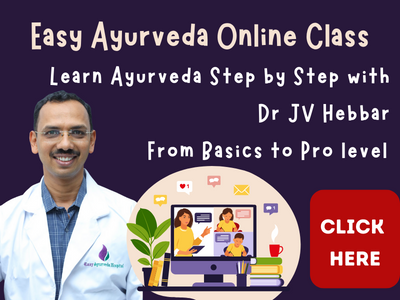Article by Dr Raghuram Y.S. MD (Ay) & Dr Manasa S, B.A.M.S
Kalaya Khanja is a illness situation which has been briefly defined within the context of Vata Vyadhi – particular and particular / unusual dysfunction brought on by severely aggravated vata, solely vata.
Reference – Madhava Nidana – Vata Vyadhi Nidanam Chapter 22, verse 60 and Sushruta Samhita Nidana Sthana, Chapter 1.
That means / Definition
कलायसेवनात् खञ्जः कलायखञ्जः।
Khanja – means ‘limping’.
Kalaya – is ‘grass pea’. It has different names additionally – white pea, Indian pea, chickling pea, blue candy pea, white vetch, chickling vetch or cicerchia. Its botanical identify is Lathyrus sativus. It’s a legume belonging to the household Fabaceae. Generally it’s grown for human consumption, as meals, and livestock feed in Asia and East Africa. Their seeds comprise a neurotoxin that causes lathyrism, a neurodegenerative illness when consumed in extra, as a main supply of protein for extended intervals.
Summing it up,
Kalaya Khanja is khanja – a neurodegenerative dysfunction / vata vyadhi marked by limping gait, which is brought about as a consequence of extreme consumption of Kalaya – Lathyrus sativus for extended intervals. So, this situation is restricted to these individuals who eat Kalaya in extra.
Synonym
कलायखञ्ज इति शास्त्रे रूढा संज्ञा; अयमेवान्यत्र खञ्जवात इत्युक्तः।मधुकोश, मा.नि.२२/६०।
Kalaya Khanja can be referred to as ‘Khanja Vata’.
Why is Kalaya Khanja thought of as Vata Vyadhi?
Kalaya has qualities just like these of vata. So, when Kalaya is consumed in extra and for an extended length, it should positively enhance vata to irregular proportions. This vata will have an effect on the nerves and tissues of the decrease limb and trigger the particular person to limp. Since Kalaya will increase vata and results in a peculiar and unusual particular vata dysfunction with vata predominant signs – unable to stroll, on this case, it’s counted amongst vata vyadhi.
Pathogenesis of Kalaya Khanja
Extreme consumption of Kalaya
↓
Aggravation of vata
↓
Vata takes sthanasamshraya – lodgement within the kati – pelvis and low again areas, sakti – thighs and pada – decrease limbs and the kandaras – tendons and ligaments of the decrease limb
↓
Trigger khanjatva – imbalance and shaking (tremors in legs) and weak point within the decrease limb at first of strolling stance, inflicting the particular person to limp
↓
That is referred to as Kalaya Khanja
As per the definition of Khanja, this situation is named Kalaya Khanja when it impacts one decrease limb. If it impacts each limbs it must be termed as Pangu itself. This has not been clarified within the textual content if Kalaya Khanja would have an effect on one or each decrease limbs, however the distinction between khanja and pangu has been given. Limp affecting one decrease limb is named khanja and if the particular person finds it tough to stroll with each limbs, it’s referred to as pangu – lameness.
Signs of Kalaya Khanja
प्रक्रामन् वेपते यस्तु खञ्जन्निव च गच्छति॥
कलायखञ्जं तं विध्यान्मुक्तसन्धिप्रबन्धनम्।सु.नि.१, मा.नि.२२/६०॥
Prakampan Vepate Yastu – the particular person feels shaky / shivers or trembles or has jerky actions as if the decrease limb is having tremors. The commentator of Madhava Nidana has additional added that these shaky actions or trembling gait is seen proper at first of strolling i.e. when the particular person will get up from resting place – sleeping or sitting place – and tries to stroll. This implies to inform that the preliminary steps are themselves uncomfortable and shaky. ‘Gamanarambhe Vepana’ i.e. trembling at first of the stroll differentiates this situation from one other situation referred to as ‘Khanja’ which additionally means ‘limping’. However in Khanja, Kalaya needn’t be an etiological issue.
Khanjan Iva Cha Gachchati – the particular person will stroll as if limping i.e. may have a limping gait. Instantly once we see that particular person strolling, we are able to sense that she or he isn’t having a straightforward time strolling and is limping alongside. The commentator of Madhava Nidana explains Khanjan Iva as ‘Vikalayan Iva’ i.e. the particular person walks as if disabled by limbs.
Mukta Sandhi Prabandhanam – or ‘Shithilikruta Sandhi Bandhanam’ (Madhava Nidana Commentary) – i.e. laxity or looseness of the joints of the decrease limb. So, the joints within the decrease limb and pelvis even have began giving means and are usually not supporting the act of strolling. This additionally exhibits the immense aggravation of vata within the joints resulting in their degeneration and destruction. The joints are usually not in a position to bear the burden of the physique and the particular person would possibly fumble whereas strolling. However, this is likely to be the precise mechanism behind limping gait and may be the preliminary course of within the pathogenesis of Kalaya Khanja.
These three are the primary signs and hallmark options of Kalaya Khanja.
Prognosis
Although the sadhyasadhyata – prognosis of Kalaya Khanja has not been defined we are able to contemplate it as sadhya i.e. curable within the preliminary part of its manifestation, when vata signs are seen afresh and will be correlated with consumption of Kalaya as etiological issue.
However, Kalaya Khanja turns into incurable –
– because the illness progresses
– when the signs are extreme,
– the illness has brought about enough harm of muscle groups and joints of the decrease limb,
– if it happens in outdated aged individuals
– if the illness is related to issues which can’t be reversed and
– if the hyperlink between the signs and Kalaya as etiological issue can’t be established and
– if the particular person retains taking Kalaya
Prevention
Protecting away the etiological components, Kalaya on this case, is the easiest way of stopping the illness or development of the illness.
Remedy of Kalaya Khanja
The mainstays of profitable remedy of Kalaya Khanja contains the beneath talked about ideas –
– early identification of the illness,
– establishing the hyperlink between signs and consumption of Kalaya,
– isolating the etiological components and
– promptly treating the illness
Nidana Parivarjana – Freely giving the consumption of Kalaya and all different vata growing meals, actions and behaviours is essential technique within the remedy of Kalaya Khanja.
Vata Vyadhi Chikitsa – Since Kalaya Khanja is a Vata dysfunction, the ideas of remedy of Vata issues are relevant for this illness too. This contains medicines, therapies, food plan and life-style adjustments.
Panchakarma Therapies – Vasti is the only option for sufferers having signs of Kalaya Khanja. Brimhana Vastis and Yapana Vastis must be administered to strengthen and nourish the muscle groups and joints and in addition to calm the nerves. They’re the very best and unparalleled within the enterprise of mitigating vata and in addition will halt the development of illness and its signs.
Exterior Therapies – Together with Vasti, correctly deliberate and executed exterior therapies are illness modifying in nature and in addition will assist in restoring the actions within the decrease limbs and the muscle groups and joints therein. They’re additionally vata calming in nature. The exterior therapies ought to embrace Abhyanga – natural oil massages, Swedana – sudation, Taila Dhara – showering of medicated oils and Ksheera Dhara – showering of medicated milk.
Helpful medicines
– Maharasnadi Kashayam
– Sahacharadi Kashayam
– Dhanwantaram Kashayam
– Gandharvahastadi Kashayam
– Ksheerabala Taila 101
– Gandharvahastadi Eranda Taila
– Nimbamritadi Eranda Taila
Fashionable Correlation
Kalaya Khanja is correlated with a situation referred to as Lathyrism. It’s a situation brought on by extreme consumption of legumes of the genus Lathyrus for extended time.
The three kinds of lathyrism are – Neuro-lathyrism, Osteo-lathyrism and Angio-lathyrism. All these situations differ of their signs and are mentioned to be incurable.
In neuro-lathyrism motor neuron loss of life happens resulting in paralysis and muscle atrophy of the decrease limbs. Osteo-lathyrism impacts the connective tissues. Angio-lathyrism impacts the blood vessels.
Kalaya Khanja is a mix of those situations. The signs Prakampan Vepate factors in direction of neuro-lathyrism. Mukta sandhi prabandhanam factors in direction of osteo-lathyrism. Khanjan iva gachchati and prakampan vepate yastu might collectively level in direction of angio-lathyrism.
To sum up,
Lathyrism is brought on by consumption of huge portions of lathyrus grain – Lathyrus sativus primarily. Lathyrus sativus is Kalaya in Ayurveda. Extreme Kalaya consumption causes Pangu and it’s referred to as Kalaya Khanja. Kalaya Khanja is defined within the context of vata vyadhi. Vata vyadhi explains a big selection of neurological, musculoskeletal and neuro-degenerative issues, all of that are concerned in lathyrism. Lathyrism, will be correlated with Kalaya khanja and thus is a vata vyadhi from Ayurveda perspective.
Associated Studying – Lathyrism


